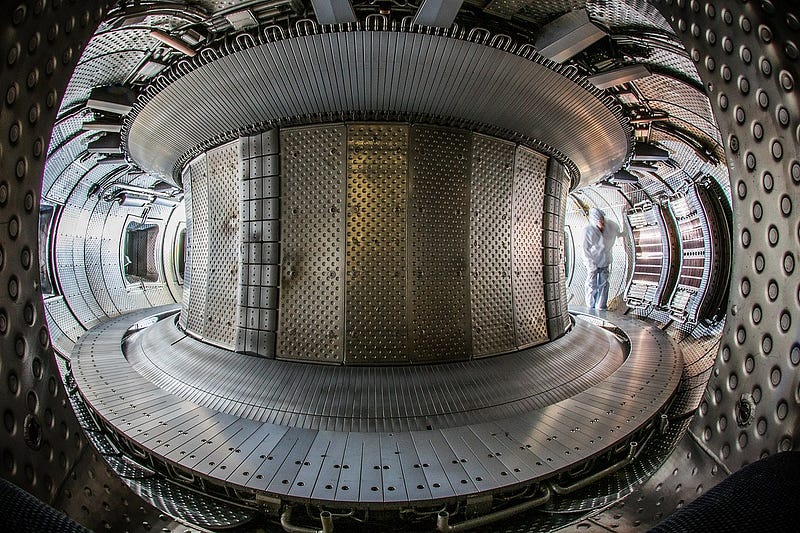The Future of Nuclear Fusion: A Breakthrough in Efficiency
Written on
Chapter 1: Understanding Nuclear Fusion
Recent advancements indicate that scientists have successfully calculated the precise amount of fuel required for the nuclear fusion process. This development is crucial, as earlier estimates were significantly inaccurate.

Nuclear fusion represents the ultimate goal in modern scientific endeavors. Achieving the energy generation process that occurs naturally in the Sun would provide humanity with an almost limitless power supply. In the face of climate change, transitioning away from fossil fuels is imperative, and nuclear fusion could help stabilize global temperatures, thereby mitigating erratic climate shifts.
How efficient is nuclear fusion? Researchers at the JET tokamak have found that one kilogram of fusion fuel can yield 10 million times more energy than an equivalent mass of coal, oil, or natural gas, with zero greenhouse gas emissions.
Section 1.1: Fuel Sources in Fusion Reactors
Nuclear fusion can be realized through various methods, though the most promising technology currently involves tokamaks. These devices are designed like a torus, with a central void. Inside, a mixture of two hydrogen isotopes—deuterium and tritium—serves as the fusion fuel. When subjected to sufficiently high temperatures, these isotopes merge, releasing vast amounts of energy.
However, replicating the conditions found in the Sun is a complex challenge. The Sun's core reaches temperatures around 15 million degrees Celsius, coupled with immense pressure—conditions that are difficult to replicate on Earth. As a result, fusion plants here will need to achieve temperatures ranging from 120 to 150 million degrees Celsius.
Furthermore, the plasma formed from heated nuclear fuel must not come into contact with the tokamak's walls. This is managed through a robust magnetic field generated by powerful electromagnets.

Section 1.2: The Greenwald Limit Explained
For over five decades, the pursuit of harnessing nuclear fusion for energy has been a topic of discussion. Numerous experimental tokamaks have been developed over the years. However, significant hurdles remain before the first operational fusion power plant can be realized.
Recent findings published in the scientific journal Physical Review Letters challenge a longstanding principle known as the Greenwald limit, which dictates the density of fuel in tokamaks. This limit, established over thirty years ago, is now being re-evaluated.
According to Paolo Ricci from the Swiss Plasma Center, "To create the plasma necessary for fusion, three conditions must be satisfied: high temperature, adequate volume, and sufficiently dense hydrogen fuel." He explains that initially, researchers understood that excessive hydrogen fuel could lead to unpredictable plasma behavior, making it impossible to confine it within the tokamak walls.
The Greenwald limit, introduced in 1988, was intended to define the maximum fuel capacity based on the tokamak's inner radius and the current flowing through the plasma.
Chapter 2: New Insights on Energy Production Potential
Recent analyses involving data from three tokamaks—the British Joint European Torus (JET), the German ASDEX Upgrade, and the Swiss TCV—have revealed that the Greenwald limit may have been underestimated by a factor of two. This discovery suggests that it is possible to create twice as much plasma within a tokamak than previously believed, potentially leading to significantly higher electricity generation.
The implications of this discovery are profound. The Greenwald limit serves as the foundation for ITER, the world's largest experimental tokamak currently under construction in France. With 80% of the project completed, ITER is set to become operational in 2025, paving the way for the subsequent development of the first fusion power plant, known as DEMO, which aims to deliver electricity to the grid by 2050.
The first video titled "When will we FINALLY achieve fusion power?" provides insights into the timeline and challenges of achieving practical fusion energy.
The second video, "Nuclear Fusion: The $65 Billion Bet on Unlimited Energy," discusses the investment and future potential of nuclear fusion technology.
Source: Physical Review Letters, phys.org, Live Science
Scientific Challenges and Triumphs
Errors and setbacks are intrinsic to scientific progress, just as much as groundbreaking successes. The road ahead for fusion energy remains intricate and demanding, but these recent revelations bring us one step closer to realizing a sustainable energy future.
Thank you for taking the time to read this article. If you found it valuable, please consider showing your support by leaving some claps or following my work!